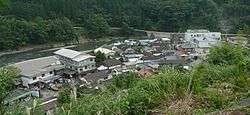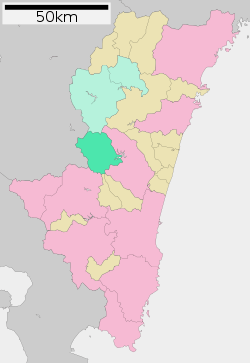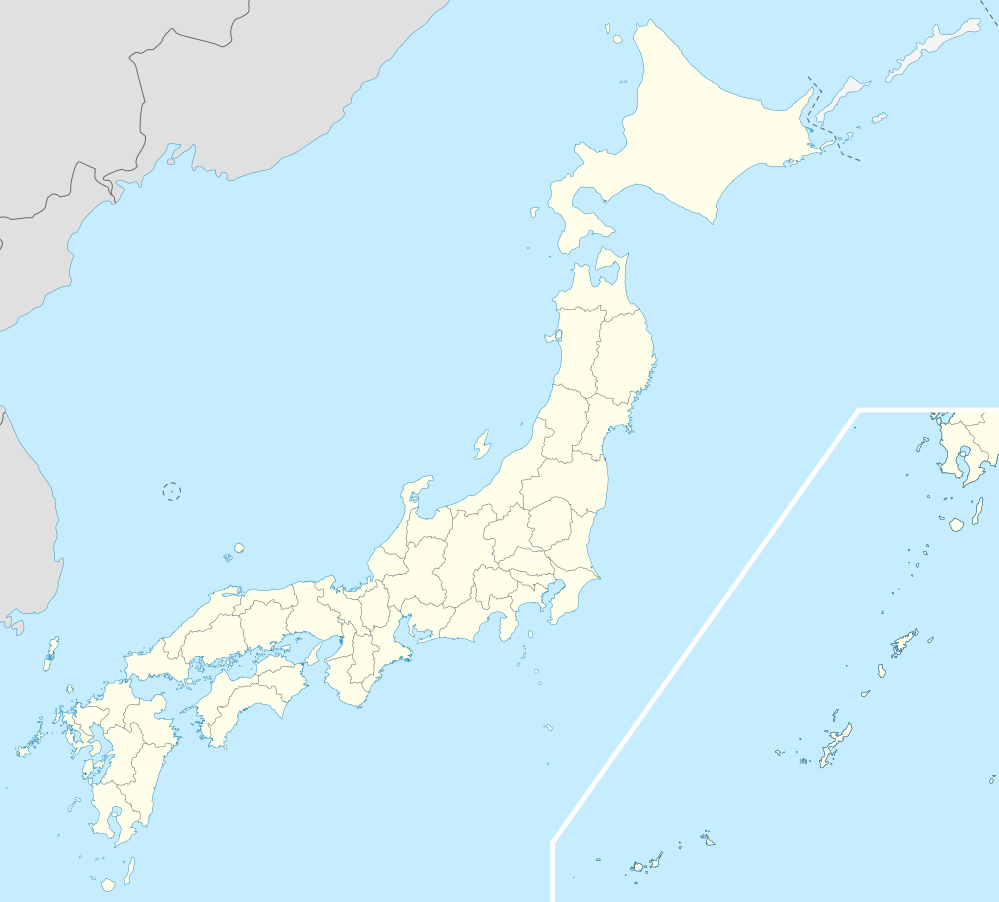Nishimera, Miyazaki
Nishimera (西米良村, Nishimera-son) is a village located in Koyu District, Miyazaki Prefecture, Japan.
Nishimera 西米良村 | |
|---|---|
Village | |
 Nishimera Village | |
Flag  Chapter | |
 Location of Nishimera in Miyazaki Prefecture | |
 Nishimera Location in Japan | |
| Coordinates: 32°14′2″N 131°9′24″E | |
| Country | Japan |
| Region | Kyushu |
| Prefecture | Miyazaki Prefecture |
| District | Koyu |
| Area | |
| • Total | 271.51 km2 (104.83 sq mi) |
| Population (October 1, 2019) | |
| • Total | 1,013 |
| • Density | 3.7/km2 (9.7/sq mi) |
| Time zone | UTC+9 (JST) |
| Website | www |
As of 1 October 2019, the village has an estimated population of 1,013[1] and the density of 3.73 persons per km². The total area is 271.51 km².
Nishimera is made up of the hamlets of Murasho, Ogawa, Koshino, Yokono, Takehara, Kanmera, and Itaya.
The main hamlet of Nishimera is called Murasho, has a population of 639 and has one traffic light. However such isolation is balanced by the mountains which surround the village and the river which runs through it.
Transportation
Highways
gollark: It's not some sort of optimizer thing, it's literally just Lagrange interpolation bodgily implemented in TypeScript.
gollark: Oh, here is the simplified version which stuff may actually let you plot: `(x - 2) * -1 / 120 * (x - 3) * (x - 4) * (x - 5) * (x - 6) + (x - 1) * 7 / 24 * (x - 3) * (x - 4) * (x - 5) * (x - 6) + (x - 1) * -9 / 4 * (x - 2) * (x - 4) * (x - 5) * (x - 6) + (x - 1) * 127 / 12 * (x - 2) * (x - 3) * (x - 5) * (x - 6) + (x - 1) * -1 / 8 * (x - 2) * (x - 3) * (x - 4) * (x - 6) + 104 * (x - 1) * (x - 2) * (x - 3) * (x - 4) * (x - 5)`.
gollark: If you like TeX, `\frac{\left( x-2\right)\cdot-1}{120}\cdot\left( x-3\right)\cdot\left( x-4\right)\cdot\left( x-5\right)\cdot\left( x-6\right)+\frac{\left( x-1\right)\cdot7}{24}\cdot\left( x-3\right)\cdot\left( x-4\right)\cdot\left( x-5\right)\cdot\left( x-6\right)+\frac{\left( x-1\right)\cdot-9}{4}\cdot\left( x-2\right)\cdot\left( x-4\right)\cdot\left( x-5\right)\cdot\left( x-6\right)+\frac{\left( x-1\right)\cdot127}{12}\cdot\left( x-2\right)\cdot\left( x-3\right)\cdot\left( x-5\right)\cdot\left( x-6\right)+\frac{\left( x-1\right)\cdot-1}{8}\cdot\left( x-2\right)\cdot\left( x-3\right)\cdot\left( x-4\right)\cdot\left( x-6\right)+104\cdot\left( x-1\right)\cdot\left( x-2\right)\cdot\left( x-3\right)\cdot\left( x-4\right)\cdot\left( x-5\right)`.
gollark: Your expression: (1 * (((x - 2) / (-1)) * ((x - 3) / (-2)) * ((x - 4) / (-3)) * ((x - 5) / (-4)) * ((x - 6) / (-5)))) + (7 * (((x - 1) / (1)) * ((x - 3) / (-1)) * ((x - 4) / (-2)) * ((x - 5) / (-3)) * ((x - 6) / (-4)))) + (27 * (((x - 1) / (2)) * ((x - 2) / (1)) * ((x - 4) / (-1)) * ((x - 5) / (-2)) * ((x - 6) / (-3)))) + (127 * (((x - 1) / (3)) * ((x - 2) / (2)) * ((x - 3) / (1)) * ((x - 5) / (-1)) * ((x - 6) / (-2)))) + (3 * (((x - 1) / (4)) * ((x - 2) / (3)) * ((x - 3) / (2)) * ((x - 4) / (1)) * ((x - 6) / (-1)))) + (12480 * (((x - 1) / (5)) * ((x - 2) / (4)) * ((x - 3) / (3)) * ((x - 4) / (2)) * ((x - 5) / (1))))
gollark: Okay, done.
References
- "Population of Nishimera Village" (in Japanese). Japan: Nishimera Village. Retrieved 28 April 2017.
External links

- Nishimera official website (in Japanese)

This article is issued from Wikipedia. The text is licensed under Creative Commons - Attribution - Sharealike. Additional terms may apply for the media files.